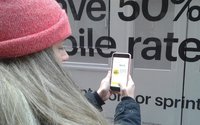Commentary
Beacons On Buses Trigger Mobile Advertising To Pedestrians
- by Chuck Martin , Staff Writer, June 9, 2016

Since their inception, beacons have been an insider sort of technology that just makes more accurate the location information of an individual for a brand or marketer.
Most of the beaconing implementations involve fixed locations, like in stores, shopping centers and stadiums.
And then there are beacons constantly on the move.
Last summer, Vector Media, the outdoor moving media company, teamed with beacon-maker Gimbal to install beacons in 500 of the double-decker buses where Vector places advertising from major brands, as I wrote about at the time (Advertising on the Move: Beacons Added to Double-Decker Buses).
The buses tend to roll in retail-heavy markets, including New York, Miami, Los Angeles and Chicago.
I checked in with Vector yesterday to see how the beaconing has been going.
The two beacons on each bus initially were used just to collect information, said Gary Greenstein, Vector’s chief revenue officer.
The idea was to learn more about the audience.
Since beacons can essentially gather a bit of information from any phone that has a beacon-enabled app on it, such as Shazam, Vector wanted to start to better understand more about the potential viewers of their mega-ads on the sides of the business.
The double-decker bus advertising by Vector started some 10 years ago in the pre-smartphone era. Beacons linked that traditional out-of-home ad model to current digital location info.
“The oldest format and the newest format are coming together,” said Luke Leonard, Vector’s head of marketing.
A few years back, Vector added Wi-Fi to the buses in which riders received ads from sponsors.
Then came the Gimbal beacons, with one unit in the front of the bus and one in the back.
When a consumer gets within about 50 feet of the bus, they can get a text message relating to an ad on the side of the bus.
Interestingly, consumer reaction is one more of surprise rather than intrusion, since the message is extremely relevant to what most of the pedestrians are viewing, according to Leonard.
“When they get the message, they are excited,” said Leonard.
“The ad itself becomes the beacon,” said Greenstein.
Continuing the new trend of integrating beacons with geofences and GPS location data, as described here last week (Beacons, GPS, Wi-Fi Combo: The New Mobile Presence), Vector is using all three location aspects.
As to results, 7% of people messaged click through and once inside after that click, 48% engage more, according to Greenstein.
For example, in one campaign for Sprint, of those who clicked through, 48% clicked to find a store near them.
A call-to-action in the messaging is the critical component, said Leonard.
While many of the 40 or so people on a bus at a given time receive location-triggered messages, two-thirds of the total messages are sent to people on sidewalks near the buses.
The location information from people on and near buses eventually will be tied to location-information at and inside stores.
The impact of the Internet of Things will literally be everywhere.
-----------------------------------------------------------------------------------------------
The MediaPost IoT Marketing Forum is being held Aug. 3 in New York. Check it out here



